Been experimenting with simple wire antennas and I've just built an Off Centre Fed dipole (OCFD) as described
here It looks like this:
I don't have 27m of free space so that leg goes up to a tree and then hangs down in an inverted L arrangement. (The co-ax if standard 50 ohm).
Using an MFJ-269 I've plotted the SWR against frequency as follows:
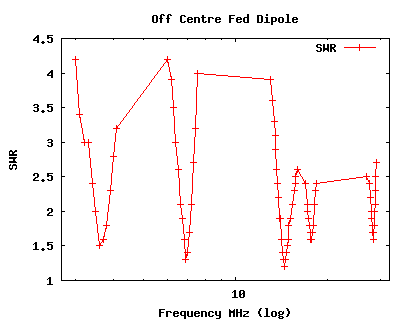
The dips in SWR are at:
- 3.6Mhz = 1.4
- 6.9Mhz = 1.3
- 14.5Mhz = 1.2
- 17.75Mhz = 1.6
- 28.3Mhz = 1.6
So 80m is spot on, 40 is slightly low, 20m is a bit high, and 10m is good. Note that I made the measurements close to the balun rather than at the end of a long co-ax run.
Interesting antenna that gets just a tiny mention in the ARRL antenna handbook but no detailed information.
I'll report back after some on-air tests. So far I'm hearing stations in New Zealand and North America very well, noise is also up but it's very hard to tell as conditions vary wildly from night to night.
Just had a contact on 20m with Eric BV4VR in Taiwan so I'm certainly getting out ok.
gnuplot notesThe graph was drawn with this gnuplot script:
set terminal png size 410, 320
set title "Off Centre Fed Dipole"
set output "OCFD.png"
set xlabel "Frequency MHz (log)"
set ylabel "SWR"
set xrange [2.7 : 32]
set log x
plot "swrMX4.txt" using 1:2 title 'SWR' with linespoints
The XRF-4 balun seems good, it looks like this:
It's well constructed with a different style of wire termination to what I've seen before (squash the wire between washers), it will be interesting to see how it degrades in the weather - I think I prefer the circular lug style connections. I would welcome an anchor point on the top to hang the balun.
Old BalunI've just received a commercial 4:1 balun, the XRF-4, and so the plot above is updated with that. Below is the original plot I posted, it's interesting that this plot is rather different from my home brew balun on a ferrite rod.
The wire is perhaps 3cm shorter than before but otherwise the only change is the balun.
The dips in SWR are at:
- 3.1Mhz
- 7.12Mhz
- 14.18Mhz
- 28.16Mhz but pretty weak
ConclusionThe Off Centre Fed Dipole seems like a very versatile antenna for covering several bands, don't forget that you need a 4:1 balun.
After living with it for a couple of days I've reverted back to my old arrangement of a 40/80 trap dipole with a 20m dipole connected to the same balun.
For me, the OCF dipole is significantly noisier than the standard dipoles particularly on 80m probably due to the fact that it's much longer and had to hang down to within a metre of the ground, compared to my normal dipole which is about 10m up at one end.
It's been a very interesting experiment though.
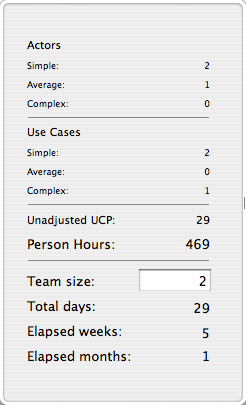 Mac software I wrote some years ago, most of the old links are broken, so here it is again.
Mac software I wrote some years ago, most of the old links are broken, so here it is again.  Last night my blog received some comment spam. These are comments that at a glance look genuine but they actually contain a link to some web site the author is trying to raise in search engine ranking by having more links to it.
Last night my blog received some comment spam. These are comments that at a glance look genuine but they actually contain a link to some web site the author is trying to raise in search engine ranking by having more links to it.
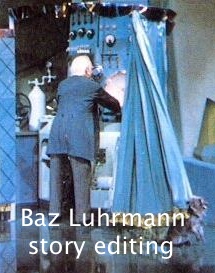 "Something tells me we're not in Cairns any more.."
"Something tells me we're not in Cairns any more.." This morning I wanted to do something related to banking on the web site when a box popped up offering to connect me to someone who could help, keyboard to keyboard.
This morning I wanted to do something related to banking on the web site when a box popped up offering to connect me to someone who could help, keyboard to keyboard. I'm doing a demo at a site that has a totally locked down Windows network so I need a wireless internet connection... Until now, my iPhone has not been jailbroken, but I finally cracked, and it works very well.
I'm doing a demo at a site that has a totally locked down Windows network so I need a wireless internet connection... Until now, my iPhone has not been jailbroken, but I finally cracked, and it works very well.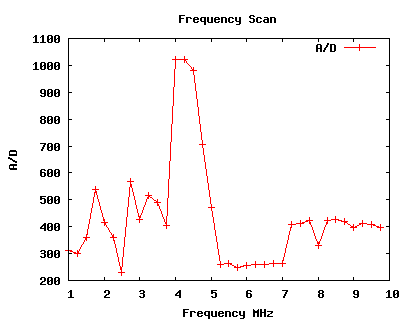
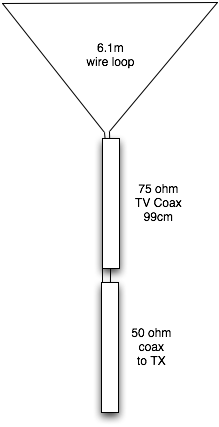 There was some activity on 6m this morning, some sort of contest, and so I did a quick web search and came across
There was some activity on 6m this morning, some sort of contest, and so I did a quick web search and came across 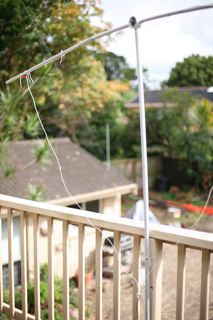 I've cut down the length of the main loop to bring it up to the 6m band but the resonance isn't as pronounced, not sure if the matching coax needs to be tweaked as well.
I've cut down the length of the main loop to bring it up to the 6m band but the resonance isn't as pronounced, not sure if the matching coax needs to be tweaked as well.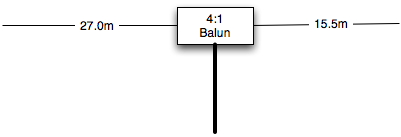


 Don't get excited, this is the story of paying to do this. The bottom line is that it costs $75 if you do it online, plus whatever penalty there is to get out of your contract...
Don't get excited, this is the story of paying to do this. The bottom line is that it costs $75 if you do it online, plus whatever penalty there is to get out of your contract...
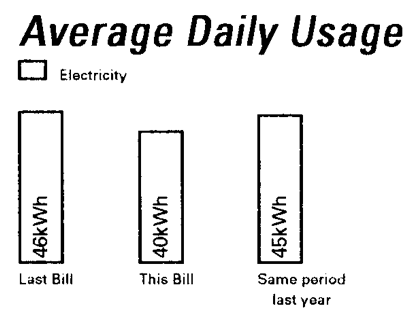
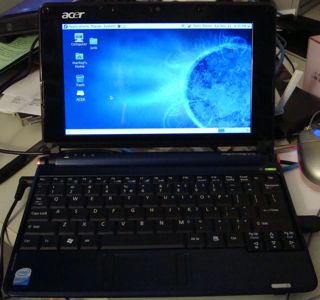 I took advantage of a
I took advantage of a  I purchased an
I purchased an 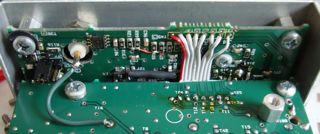
 MFSK16 is a much wider signal than the little PSK31 pairs, it looks like this on the waterfall display.
MFSK16 is a much wider signal than the little PSK31 pairs, it looks like this on the waterfall display.
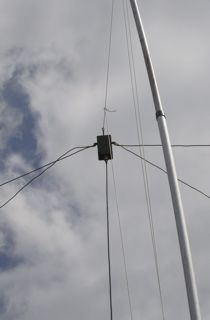 For some time I've been switching between a 40/80m trap dipole and a 20m dipole but it's a nuisance taking one down to put the other up.
For some time I've been switching between a 40/80m trap dipole and a 20m dipole but it's a nuisance taking one down to put the other up.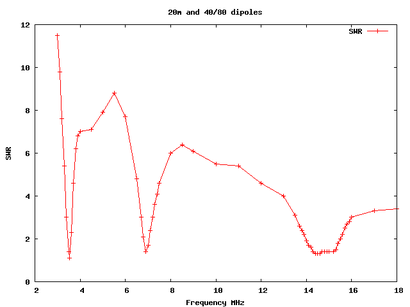
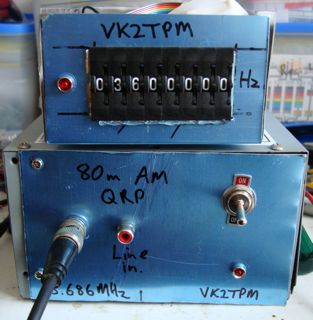 I've simply combined two recent projects, my
I've simply combined two recent projects, my 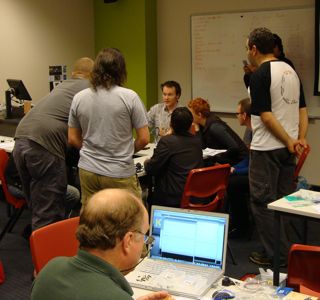 Today I attended an "Advanced
Today I attended an "Advanced 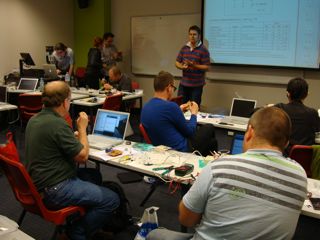
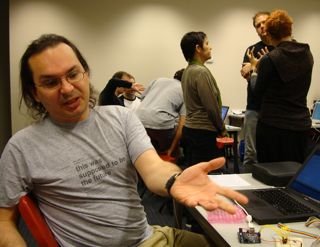 I'm sure this workshop will benefit from a run-through and next time it will be a little better organised.
I'm sure this workshop will benefit from a run-through and next time it will be a little better organised.